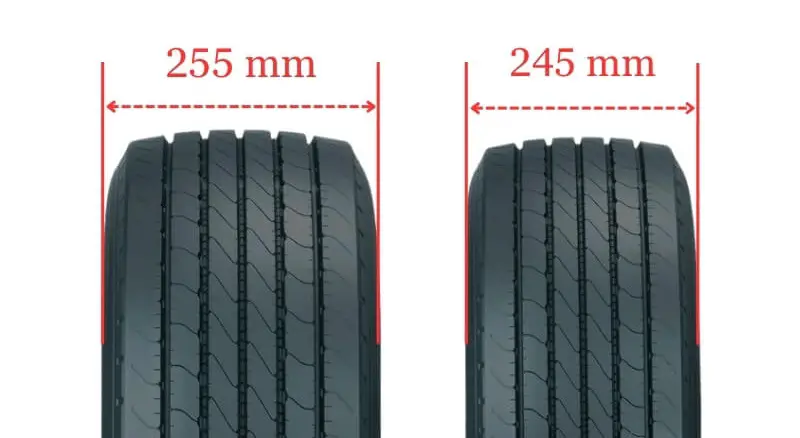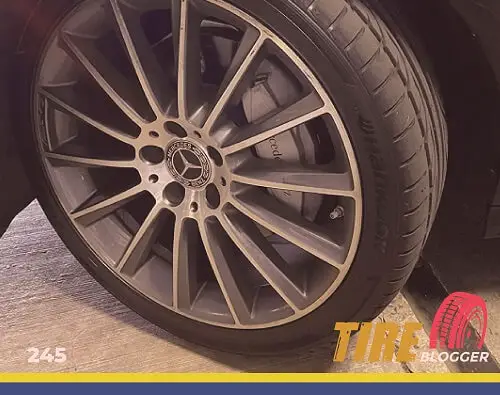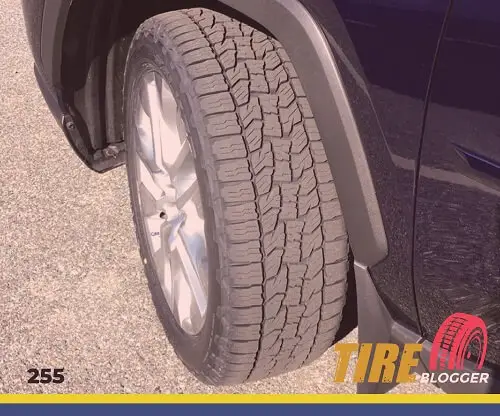245 vs 255 Tires

The main difference between a 245 tire and a 255 tire is the tread width, with the 255 tire being 10mm (0.4 inches) wider than the 245 tire. This slightly wider tread provides more grip and stability, especially in adverse conditions, but the difference is quite minor.
245 vs 255 Tires
This comparison table allows you to easily identify differences between two tire sizes.
| Tire Size 245 | Tire Size 255 |
|---|---|
| Narrower Main Tread Width | Slightly Wider Main Tread |
| Marginally Better Fuel Efficiency | Slightly Lower Fuel Efficiency |
| More Responsive Handling | More Stable Handling |
| Quieter Ride on Smooth Roads | Slightly Smoother Ride Quality |
| Slightly Less Tread Durability | Slightly More Durable Treadwear |
| Minimal Visual Difference | Slightly More Muscular Look |
| Lower Rolling Resistance | Slightly Higher Rolling Resistance |
| Less Traction in Adverse Conditions | Improved Traction in Adverse Conditions |
| Minimally Less Ground Clearance | Slightly More Ground Clearance |
Ground Clearance
The slightly greater width of a 255 tire will provide a slight increase in ground clearance compared to a 245.
This can help prevent bottoming out over bumps or obstacles. However, we’re only talking about a few millimeters of extra clearance, so the advantage is marginal.

Gas Mileage
With regards to gas mileage, a 245 may have a minor advantage over a 255 due to its smaller contact patch, resulting in slightly less rolling resistance.
But modern tire compounds minimize this difference so that any potential mileage benefit would be barely noticeable in real-world conditions.
Ride Comfort
Larger tires can provide a smoother ride, but with only a 10mm width difference between 245s and 255s, the impact on comfort is negligible.
Both offer adequate absorption of bumps and vibrations for a comfortable ride. Ride quality depends much more on tire construction and inflation than this slight size difference.
Aesthetics Look
The slightly wider 255 may look a bit more muscular on certain vehicles. Still, the difference is so subtle that it likely won’t factor into the aesthetic appeal.
Most people would be hard-pressed to visually tell the difference between a 245 and a 255 tire on a given car.

Handling & Stability
The 255 offers a small enhancement in stability and traction from its wider footprint. But a 245’s slightly smaller contact patch significantly improves responsive steering and handling. For most drivers, any handling difference between the two would be imperceptible.
Noise & Vibration
With proper inflation and tread depth, noise and vibration levels should be similar between the two sizes.
The 255 may dampen vibrations slightly better, but mounting, tire construction, tread pattern, and road surface play a much bigger role in noise and vibration characteristics.
Durability & Wear
The 10mm wider 255 distributes wear over a slightly larger footprint, potentially increasing tread life.
But modern tires exhibit similar durability between these two popular sizes. Rotation during maintenance, alignment, and inflation have a much greater impact on tire life.

Adverse Conditions
The 255’s modestly wider tread helps supply more snow, mud, or gravel grip. However, modern tread compounds enable both sizes to perform well in adverse conditions.
The difference will be hard to discern for most drivers except in specialized off-road applications.
Difference Between 245 and 255 Tires
The primary difference between 245 and 255 tire sizes is the section width, with 255 tires being 10mm wider than 245 tires. This difference in width can impact various aspects of vehicle performance and handling.
Can I Use 255 Tires Instead of 245?
Yes, you can use 255 tires instead of 245 tires. The ideal rim width range for 245 tires overlaps with the range for 255 tires, making the switch possible.
Also, keep in mind that the aspect ratio and rim diameter should be compatible with your current setup. In the event of a mismatch, the overall diameter difference should not surpass 3% to ensure speedometer accuracy and vehicle performance remain unaffected.

Can I Use 245 Tires Instead of 255?
Yes, it is possible to use 245 tires instead of 255 tires. The ideal rim width range for 255 tires overlaps with the range for 245 tires, allowing for the switch.
It’s vital to choose options with an aspect ratio and rim diameter that align with your existing setup. If a perfect match is not available, aim to keep the overall diameter difference within 3% to maintain accurate speedometer readings and optimal vehicle performance.
Can I Put 255 Tires on 245 Rims?
Yes, you can put 255 tires on rims designed for 245 tires. The ideal rim width range for 245 tires (7.5-9.0 inches) overlaps with the range for 255 tires (8.0-9.5 inches), ensuring proper fitment.

Can I Put 245 Tires on 255 Rims?
Yes, you can put 245 tires on rims designed for 255 tires. The ideal rim width range for 255 tires (8.0-9.5 inches) overlaps with the range for 245 tires (7.5-9.0 inches), allowing for proper fitment.
Our Observation
After comparing the nuances between 245 and 255 tires, I don’t see any major differences that would sway my personal choice one way or the other. The slightly wider 255 provides only negligible advantages in off-road capability, aesthetics, and adverse weather handling.
For daily driving needs, either size will provide a similar experience in terms of ride comfort, noise, vibrations, and longevity. Unless I was an avid off-roader needing maximum traction and stability.
The 255’s modest benefits over the 245 would not justify choosing it purely for performance reasons. Ultimately, either size could fit my driving needs equally well.

Meet Caitlin McCormack, a Tire Size Expert and Blogger Passionate About Everything Related to Tires. With Years of Experience in the Tire Industry, Caitlin Has Become an Expert in Tire Sizes and Their Impact on Vehicle Performance.
